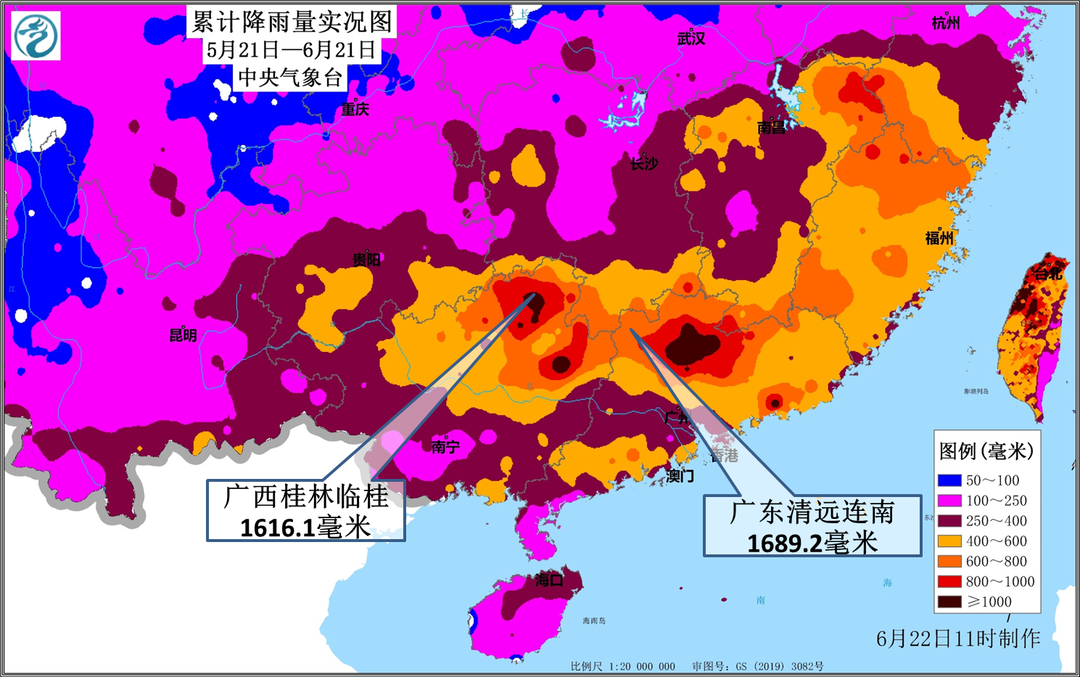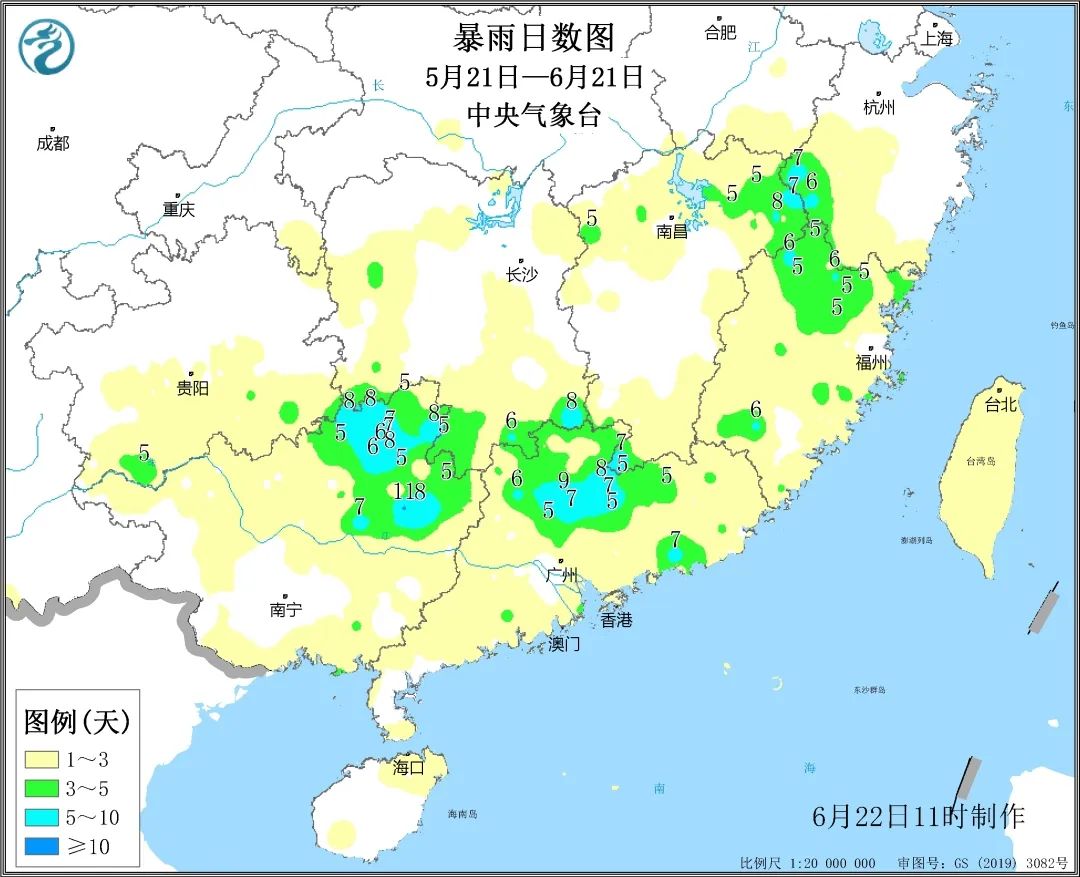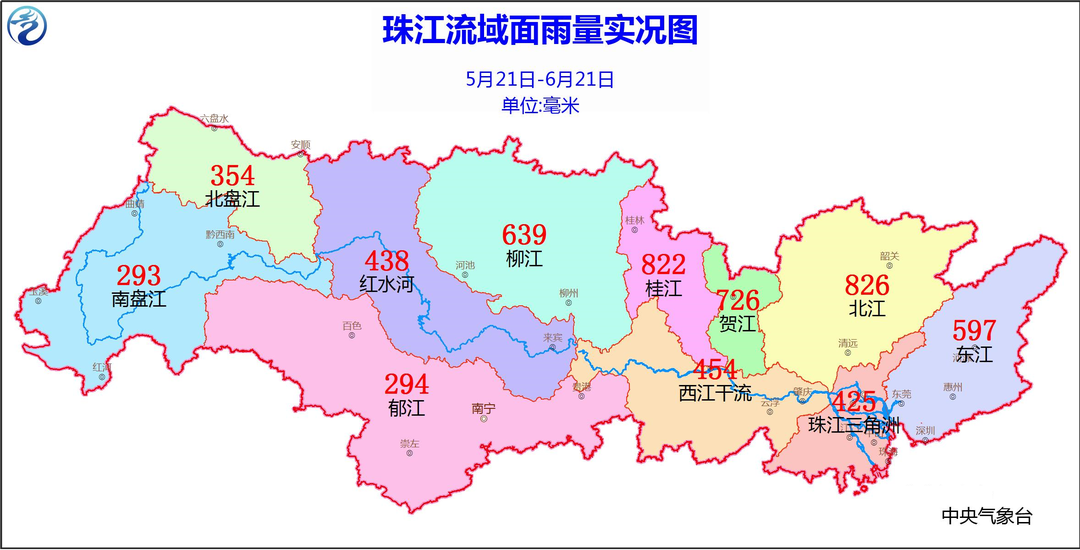South China Dragon Boat Water Ending Precipitation History 2 | Expert Interpretation
Author:China Meteorological Administr Time:2022.06.23

According to the latest news of the Central Meteorological Observatory
South China "Dragon Boat Water" tends to end
History of precipitation volume second
So why is the "Dragon Boat Water" strong this year?
What are the characteristics?
Meteorological experts interpret for you
Core reading
From late May to mid -June each year is a concentrated period of precipitation during the flood season in South China, because the rainfall period is also known as "Dragon Boat Water" around the Dragon Boat Festival.
During the "Dragon Boat Water" in South China this year (May 21 to June 21), the average rainfall of Guangdong, Guangxi, and Hainan was 472.5 mm, which was the second since 1951. This year, the "Dragon Boat Water" has the characteristics of cumulative rainfall, uneven space distribution, frequent rainfalling process, and many heavy rainfall days. Multi -site rainfall breaks its historical extreme value and has strong extremes.
Affected by heavy rainfall, the ruminities, large -scale urban and rural waterlogging and geological disasters in Guangdong and Guangxi appeared in Guangdong and Guangxi.
As of June 23, the precipitation during the flood season in South China has basically ended, but floods and geological disasters are lagging, and they need to continue to do relevant disaster defense.
01
What is the reason why this year's "Dragon Boat Water" is strong?
Since May, cold air activities affecting the eastern regions of my country have been frequent. Especially in June, the cold vortex in the Northeast was very active and strengthened to the south. On the one hand, the cold air guided the cold air south to affect the southern part of my country to South China, which caused the temperature in the above areas to be lower than the same period of the year. Water vapor transmission from the Northwest Pacific and South China Sea continues to affect South China.
At the same time, with the outbreak and establishment of the summer wind, the Southwest Water and Vapigas guided by the monsoon circulation to South China is also strong. The above reasons have led to the abnormal precipitation during the flood season in South China.
Positioning: cold air is not weak, and water vapor transportation is strong
02
What are the characteristics of South China rainfall?
Features 1: The cumulative rainfall is large, and the heavy rainfall area is mainly located in northern Gui, northern Guangdong
From May 21st to June 21st, the cumulative rainfall of most of Guangdong, most of Guangxi, and the central and eastern parts of Hainan Island were 200 to 500 mm. There are 600 to 1,000 mm in parts of Wuzhou and Laibin, and more than 1,000 mm in Shaoguan and Qingyuan, Guangxi Guilin and Hezhou, Guangdong; of which Dalima Mountain Town, Liannan County, Guangdong, reached 1689.2 mm, and 1652.7 Xinjiang Town, Wengyuan County Millimeter; 1616.1 mm in Linui District, Guilin, Guangxi, and 1612.4 mm in Rongshui County, Liuzhou.

Feature two: frequent precipitation process, the number of heavy rain days is large
During the "Dragon Boat Water" period, 6 consecutive heavy rainfalls appeared in South China, respectively, from May 21-24, 27-30, June 3-6, 7-11, 12-16, 17-21, 17-21 day. There are generally 5 to 8 days in the number of heavy rains in the northeast of Guangxi and the northern part of Guangdong, and Montana in Guangxi reaches 11 days; the number of heavy rains in the above areas is 2 to 4 days, and Wengyuan, Guangdong has 4 days.

Feature three: Strong multi -site breakthrough historical pole value
During the "Dragon Boat Water", the average rainfall of South China (Guangdong, Guangxi, Hainan) was 472.5 mm, more than 2nd since 1951, second only to 2008.
in--
The average rainfall of Guangdong Province was 514.5 mm, which was 54%more than the same period, and it was more than 3rd since 1951. The "Dragon Boat Water" in 18 counties and cities including Lechang and Wengyuan broke the historical record.
The average rainfall in Guangxi was 490.8 millimeters, the most since 1951; the cumulative rainfall in 17 counties and cities including Sanjiang, Longsheng, and Lingui broke the history of the same period.
During the period, the rainfall of the 3 national meteorological observation stations in Xing'an, Huanjiang, and Shaoguan, Huanjiang, and Guangdong, and Shaoguan, Guangxi exceeded the historical extreme value since the establishment of the station; the 6 stations exceeded the June polar value. In addition, the maximum rainfall of the maximum, 3 hours, and 6 hours of Guangxi reached 149.4 mm, 271.6 mm, and 427.6 mm, respectively. The historical value of the district.
03
Where is the watershed flood?
In the later period of "Dragon Boat Water", affected by continuous rainfall, watershed floods, urban and rural waterlogging and geological disasters in Guangdong and Guangxi appeared.
From May 21st to June 21st, the average rainfall of the Pearl River Basin was 477.8 mm, which was 64%more than the same period of the year, and it was more than 2nd since 1951.
Affected by the continued heavy rainfall, Xijiang had four number floods on May 30, June 6, 12, and 19, respectively; Beijiang had two number floods on June 14 and 19, respectively. At present, the Flood No. 4 in Xijiang is evolving, and the water level will maintain a high water level for a long time; the flood No. 2 of Beijiang has developed into a large flood, and the flood prevention situation is extremely severe.
Since May 21, Yujiang, Hongshui River, Liujiang, Guijiang, Xijiang, and Dongjiang, Beijiang, Hejiang and other sub -waters in the small and small rivers in the small river floods in the sub -waters of the river in Guangxi. Guijiang tributary Lingqu, Guangdong Yingde Feilai Gorge, and Shijiao water level super historical measurement records.

04
What is the future weather in South China?
It is expected that from June 23 to 30, South China will focus on dispersible rainfall weather. However, the current water content of the soil is saturated, the high water level of the river reservoir is operated, and floods and geological disasters are lagging. It is necessary to continue to do a good job of relevant disaster defense.
Produced by China Meteorological Administration Xuanke Center (China Meteorological News Agency)
Source: Central Meteorological Observatory Editor:
- END -
300 million!Baiyangdian upstream abandoned mining ecological restoration project is supported by central funds
Recently, the Ministry of Finance and the Ministry of Natural Resources released the results of the competitive review of the abandoned mining ecological restoration demonstration project in 2022. The
Dongping County Pengji Street (Binhe New District): Actively cope with strong and stream weather to do a good job of flood prevention work

Facing the sudden and strong stream weather, Pengji Street in Dongping County quic...